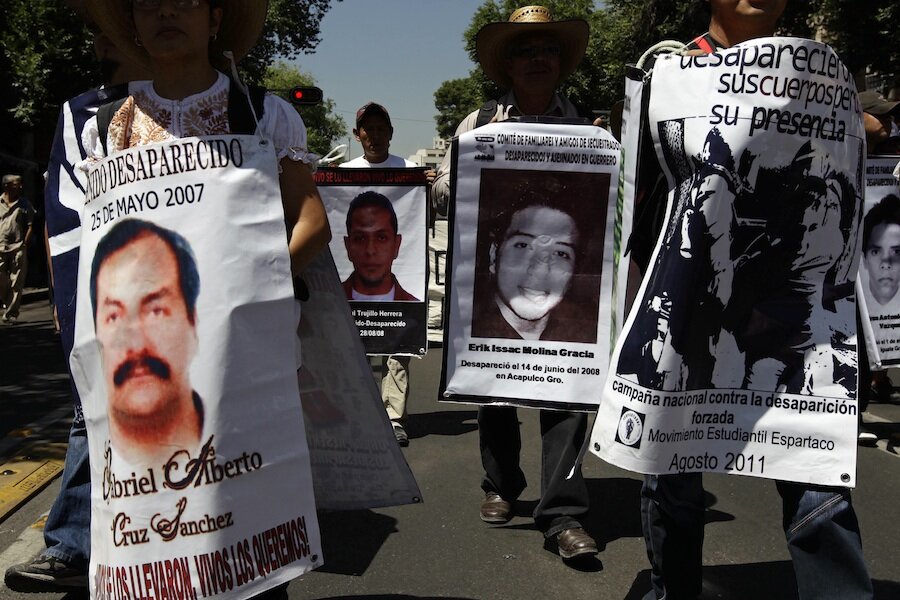Keeping count of Mexico's missing
Loading...
| Mexico City
One of the startling unknowns in the story of Mexico’s recent wave of violence is just how many people can be counted among its disappeared.
An estimated 14,000 to 45,000 people disappeared in Mexico between 2006 and 2012. That's a big discrepancy, and depends on whether you're looking at recently revised government statistics or numbers compiled by human rights groups.
But Mexico's disappearances – a country that isn't officially at war or suffering a dictatorship – rival the numbers of missing from notable conflicts around the region. Roughly 30,000 people disappeared under Argentina’s military dictatorship in the 1970s and '80s, and the more recent estimates of 30,000 disappeared in Colombia’s decades-long internal conflict.
Part of the challenge reflects a basic lack of government transparency in Mexico. Until recently, the government didn't even acknowledge publicly that there was a federal database tracking disappearances. There's also the issue of sharing critical evidence and information between federal officials and state and local governments: Mexico has barely scratched the surface of making cooperative efforts to track and solve cases of the disappeared.
As families speak out and demand that the government take responsibility for the violence, some are hopeful that it will encourage Mexican officials to seriously address the issue.
“I don’t think we have any other problem that is bigger in Mexico than the violence and securities issues,” said Julio Hernandez, one of the commissioners for the recently established Executive Commission for Victims’ Rights. “There is some interest in the government to make things better, but the problem is huge. There is never going to be enough money for these problems, but that should not be an excuse.”
A numbers game?
Under former President Felipe Calderón, Mexico only sporadically provided data on those killed or disappeared. When President Enrique Peña Nieto came to power at the end of 2012, he announced the government’s estimate that roughly 26,000 people disappeared between 2006 and 2012. That number was later lowered to 16,000 after President Peña Nieto's administration reviewed the public database. An additional 7,615 people have disappeared since Peña Nieto took office, the government announced in June.
Human rights groups say these numbers are being intentionally underestimated to make the government look better. The government counters that this is the result of decreasing crime and violence nationally.
Part of the challenge facing independent observers in confirming the accuracy of the numbers of missing persons is that identifying details, such as age or the location of a disappearance, are not made public. There is also little information on the circumstances of the disappearance, making it difficult to use government data to establish patterns.
While the majority of cases appear to indicate the work of drug cartels, a 2013 Human Rights Watch investigation of 249 disappearances in Mexico during the Calderón administration found evidence that two-thirds of the cases indicated some kind of government involvement.
Avoiding 'just a number'
New laws protecting victims rights have required the federal government to establish a national registry of those who have disappeared, using the existing databases as a starting point, but progress has been slow.
Federal authorities have had mixed results collecting state and local data from mass graves, reports that were filed, and genetic information that was collected. For example, only 12 of Mexico’s 32 states have fully complied with the legislation requiring a national registry – while states with higher rates of disappearances, such as Michoacán and Tamaulipas, have resisted providing more than token participation.
“It is expensive to keep a database, and even more expensive to make sure that it is interconnected,” Mr. Hernandez says. He says his organization, the Executive Commission for Victims’ Rights, is working through more than 100 databases to create a fuller picture of the status and progress of each case.
Hernandez, who became a human rights activist following the disappearance of his godson in 2011, hopes the national registry will also serve to honor the memories of those missing.
“We want the national registry to be more than just a list of victims and cases – we want it to include the histories of the victims and the pain that they have endured,” Hernandez says. “We want it to be a very human list - we are trying to avoid just a number.”







